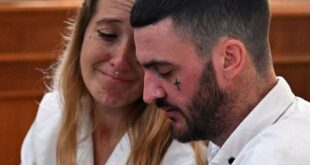King Charles III’s long-awaited coronation takes place on Saturday, with thousands of people flocking to London to witness the historic event, and millions more set to watch on television at home.
Such an occasion mean Britain’s priceless Crown Jewels will be removed from the Tower of London, where they are kept under armed guard, and will be heavily involved in the service.
Among them are four swords that each play an important part of the ceremony. Here is everything you need to know about them.
What are the swords involved in the coronation?
There are five swords in total involved in the coronation ceremony. Three of the swords – the Sword of Temporal Justice, Sword of Spiritual Justice, and Sword of Mercy – that are meant to represent kingly virtues. The practice of carrying three swords dates back to the coronation of Richard the Lionheart in 1189.
The Sword of Temporal Justice signifies the monarch’s role as head of the Armed Forces, and will be borne by General Lord Houghton of Richmond.
The Sword of Spiritual Justice symbolises the King as Defender of the Faith, and will be carried by Lord Richards of Herstmonceux.
The Sword of Mercy, also known as the Curtana, has a blunted tip to symbolise the sovereign’s mercy. It will be borne by Air Chief Marshal Peach.
All three are carried pointing upwards, unsheathed without their scabbards, in the coronation procession in the abbey. Together with the Coronation Spoon, the three swords – which date from the reign of Charles I – were the only pieces of the coronation regalia to survive the English Civil War.
There is also the 17th-century Sword of State, which is carried in procession to the abbey. Its silver-gilt hilt features the form of a lion and unicorn, and the wooden scabbard is covered in red velvet with silver-gilt rose, thistle and fleur-de-lis emblems. This sword is also used during the State Opening of Parliament. It will be carried by Tory MP Penny Mordaunt, in her role as Lord President of the Council.
The intricate tapered sword, made for King George IV’s 1821 coronation, has a hilt encrusted with diamonds, rubies and emeralds and a scabbard decorated with jewelled roses, thistles and shamrocks.
Then there is the Sword of Offering, which symbolises royal power and the monarch accepting his duty and knightly virtues.
The Archbishop of Canterbury blesses the sword and then delivers it to the monarch with the injunction that it should be used for the protection of good and the punishment of evil. The sword is then offered on the altar.
One of the peers traditionally offers the price of 100 silver shillings for the sword. The peer then draws the sword and carries it without its scabbard before the monarch for the rest of the service.
At the King’s coronation the sword will be borne by Petty Officer Amy Taylor – the first ever woman to have the honour.
King’s coronation schedule
The King and Queen will be crowned at midday on Saturday 6 May at Westminster Abbey.
Here is the full timetable of events:
- 6am – viewing areas open along the procession route
- 7.15-8.30am – guests to Westminster Abbey begin to arrive at security checkpoints in Victoria Tower Gardens
- 9am – congregation to be seated inside the abbey
- 9.30-10.45am – heads of state, overseas government representatives, Government ministers, First Ministers, former PMs, foreign royals and members of the Royal Family arrive
- 9.45am – the Sovereign’s Escort of the Household Cavalry begin to gather ready for the procession from Buckingham Palace
- 10.20am – the King and Queen’s procession sets off from the Palace
- 10.53am – the King and Queen arrive at Westminster Abbey
- 11am – Charles and Camilla enter the abbey through the Great West Door and the service begins
- 12pm – the King is crowned. The Archbishop of Canterbury places the St Edward’s crown on Charles’s head. Trumpets will sound and gun salutes will be fired across the UK
- 1pm – the service ends and the newly crowned King and Queen begin their coronation procession back to Buckingham Palace in the Gold State Coach
- 1.33pm – Charles and Camilla are expected to enter Buckingham Palace through the Centre Arch
- 1.45pm – the King and Queen receive a royal salute from the military in the Palace gardens
- Around 2.15pm – the King, Queen and members of the Royal Family appear on the Palace balcony to watch the flypast
According to Buckingham Palace, the coronation itself – which is expected to be scaled back from previous versions – will be “a solemn religious service, as well as an occasion for celebration and pageantry”.
The service will “reflect the monarch’s role today and look towards the future, while being rooted in longstanding traditions and pageantry”.
The coronation of King Charles III
Here’s a full timetable of the coronation, including when Charles will actually be crowned, and details of the concert.
The ceremony has taken an astonishing amount of preparation, with Operation Golden Orb – decades in the planning – bringing in snipers and police officers from across the country to aid security. The coronation will also feature the biggest military procession in 70 years, no small feat of logistics, but still intends to be the most sustainable ever.
But the event has not been without controversy. The option for the public to pledge allegiance to the new monarch sparked resistance, including from i‘s own Stefano Hatfield, and the new King’s relationship with his second son will be under fierce scrutiny, with Jennie Bond blaming his emotional illiteracy for the breakdown of their relationship.
This week, The i Podcast looks at whether King Charles III could be the last monarch of a Commonwealth realm which was born from the British Empire and funded by the proceeds of slavery. Listen here: Apple Podcasts | Spotify | Acast | Wherever you listen
Source link



